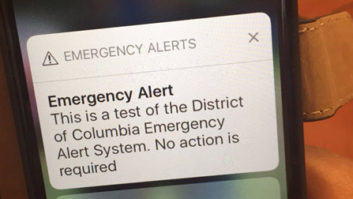
Don Miller works in emergency management for the state of Washington. He well remembers a particular day when the importance of his job struck home.
“California called us: ‘We’ve got someone heading up I-5. We think he’s in the Tacoma area.’ So we put out an Amber Alert.”
A state employee in a Department of Transportation truck heard the alert and realized he was in traffic right behind the abductor’s vehicle — just 20 miles from the Canadian border.
“They got him, and they got him quick,” Miller recounted. “Washington State Police were screaming on the phone, ‘We got him! We got him!’”
Miller’s job as telecommunications and warning systems manager for the Washington Military Department means he spends much of his time in a thicket of bureaucratic letters: IPAWS and PPW, FEMA and EAS, SECC and CAP. But he knows that these eye-glazing acronyms affect actual people.

Don Miller. ‘We want to do everything in our powers to protect our vulnerable children from predators.’ “I’ve been with state emergency management for 20 years,” he told me. “We’ve had a lot of challenges — earthquakes, a 6.8, hundreds of millions of dollars in damage; floods, fires, tornadoes, ice storms, wind storms — the whole gamut. I have 50 sirens along the coast, up to 80 planned; we have 20 in eastern Washington for a chemical stockpile, automatic ring-down circuits, radio systems around the state.” The job, he said, is very rewarding.
Miller, ham sign KE7UUK, is a retired U.S. Army telecommunications warrant officer with a degree in accounting, a manager who still pulls his own cable. He co-chairs the State Emergency Communications Committee with Clay Freinwald, a past recipient of Radio World’s Excellence in Engineering Award.
Miller and Washington state also are leaders in efforts to improve the nation’s alerting infrastructure.
He was on the board of the Partnership for Public Warning, which developed the Common Alerting Protocol and promoted its adoption by federal regulators. Washington participated in a Federal Emergency Management Agency pilot project of CAP in 2004, which helped influence the national plan now being implemented.
No static at all
The state decided early that its own alerting system, relying on analog radio links, was insufficient. Static and noise on EAS alerts had long been a concern. If the public couldn’t understand an alert, what good was the message?
After one Amber Alert with particularly poor audio quality, Miller and others set out to clean up the system. They secured a quarter of a million dollars to buy hardware for 78 EAS gateway broadcasters in Washington’s 17 emergency management regions. Some 220 other stations receive alerts relayed by those 78. The new hardware can receive digital alerts and recorded files via the Internet.
“Our governor and our Domestic Executive Group made this project a funding priority during good fiscal times because we want to do everything in our powers to protect our vulnerable children from predators.”
This was a state project, though in Washington most alerts are issued by counties. County-level activations via CAP went live in November. All 39 counties now can access a secure website to generate alerts. That site, operated by contractor MyStateUSA, sends the alerts to an interface box on the state relay network, which passes them along to the broadcast chain. Station boxes then are programmed to relay or ignore alerts depending on the type of alert.
Miller himself programmed all of the new Sage Alerting Systems boxes bought by the state. “We now have 78 CAP boxes at all LP1/2 stations and all state-owned college radio stations. All LP1/2 stations are now receiving CAP alerts directly from MyStateUSA via polling or static IP addresses. Those LP1/2 stations are still monitored by all other stations in Washington per the monitoring assignments in the state plan.”
The resulting audio to listeners, Miller said, is superb; and he says the performance improvement was only possible by moving to CAP. “We’ve gotten Amber Alerts that were crystal-clear in places where the radio signals had made it impossible to have any alerts.
“I especially like the female text-to-speech engine that is used — clear audio, sent with the authority and urgency that only a female voice can impart to the listening audience, especially to the male members of our society.” He also likes that he can see all alerts sent by any activation point in the state on one log.
“CAP is now the primary tool for sending EAS alerts in Washington state; and the old radio-based system is the backup. Most broadcasters like the new system. What’s not to like about clear audio? Broadcasters know that they will now receive an alert with crystal-clear audio that they can relay to the public.”
Work ongoing
I asked Miller for lessons about CAP that might benefit other managers.
“I would recommend that other states start distribution with their LP1 and LP2 stations. Get those on board; those are usually large and powerful stations. Also, I would not recommend using static IPs for EAS. Make sure every box you have polls the server. Static IP addresses change; you may send an alert and it doesn’t get to that box.”
But, he points out, each state may be structured differently, so it’s difficult to make sweeping recommendations.
“In North Carolina, my understanding is that they have one activation point. Other states may be like us; we’re ‘home rule,’ all 39 counties have the responsibility to warn their public, or they call us and ask us to do it for them. Other states may have other legal parameters.” He told me he’d be happy to talk with any state emergency official or broadcaster who has questions.
Meanwhile his CAP-related work is not done. Washington must redo its state plan and monitoring assignments to reflect the new system and make sure every CAP box receives both the new CAP and the old analog signals. Also, final parameters from the federal government — for unsettled matters like the proposed “governor’s must-carry” message — might require tweaks to the installed gear; but because the new hardware is Flash-compatible, Miller says it can be updated easily.
Further, another 220 or so broadcasters must still buy equipment to comply with the federal CAP-compliance deadline later this year. While those purchases will not be state-funded, Miller is providing advice and assistance to any stations that ask. He can help with programming, explain the activation sequence, show how 911 dispatch centers activate alerts and explain that an alert can be pushed to the station’s EAS box via IP or pulled from a secure server.
Relations between the state’s emergency officials and broadcasters, he said, are excellent.
“I just did a briefing for the SBE Seattle a couple weeks ago; we had about 36 engineers. I went over the entire process of how we’re migrating from the old analog system into the new CAP digital world for alerting. There were a lot of positive comments; and they really like the new audio on it. Now they’re not going to get phone calls asking, ‘What did you send over the air?’ That’s what the public deserves, to be able to know what to do in times of disasters.”
He returned to the point that alerting affects real people. Miller is particularly passionate about the safety of children. He wears a lanyard around his neck that promotes www.missingkids.com. He reminds himself that the state’s first Amber Alert was issued for Sofia Juarez, who was abducted at age 3 and still hasn’t been found.
“We don’t want anyone abducting our children, we have seen too much of it in the past.”
You can read Washington state’s Amber plan online.
Comment on this or any article. Write to [email protected].












